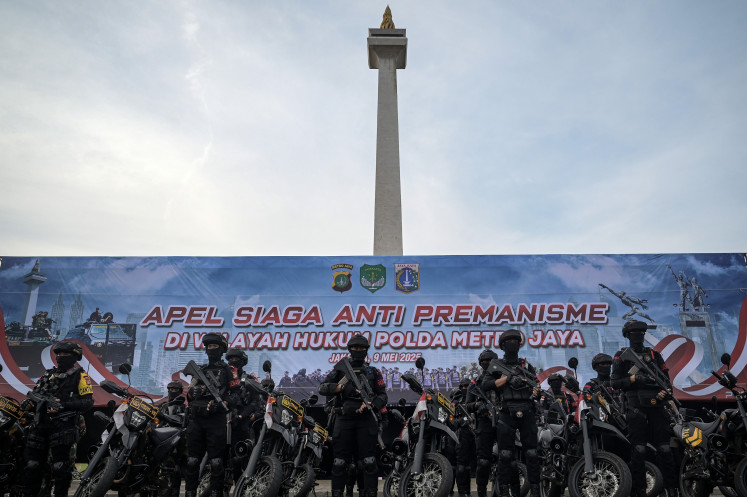One Map Policy to resolve conflicts
The government officially launched on Tuesday the “One Map Policy” that introduces one reference, one standard and one geospatial information map to solve the country’s long-rotted spatial problems, such as overlapping land use, which often cause conflict
Change text size
Gift Premium Articles
to Anyone

The government officially launched on Tuesday the “One Map Policy” that introduces one reference, one standard and one geospatial information map to solve the country’s long-rotted spatial problems, such as overlapping land use, which often cause conflict.
“There are too many overlapping uses of land in this country. We have to deal with this problem,” said President Joko “Jokowi” Widodo during the launch in Jakarta.
Aside from helping the resolve overlapping land use, Jokowi said a standardized map was crucial to supporting national development planning with more accurate spatial data. For instance, the map would help pinpoint where a dam should be constructed to ensure the best irrigation system, so as to avoid overlapping with other uses of land, he said.
The government introduced a map with a scale of 1:50,000. It has compiled and merged 83 thematic maps out of the targeted 85 from 19 ministries and institutions, as well as 34 provincial administrations.
The thematic maps come from various sectors, ranging from maps for mining permits and forest conservation, to railway and transmigration. From the compiled data, the Geospatial Information Agency then made an indicative map showing the overlapping uses of land and also mapped the areas that had the most critical overlaps in use of land.
From the indicative map, for example, it was found that in Kalimantan, 19.3 percent of its 10.4 million hectares of land was in use by multiple sectors, such as mining, protected forests, plantations and residential areas. A similar situation was also seen in Sumatra, where 6.4 million ha, 13.3 percent of the island, is used for multiple purposes.
Jokowi highlighted that the multiple use of land was the root of the problem as to why the One Map Policy had been delayed, saying that “they [the parties] are worried their interests will suffer if the map exists.”
At the same event, Coordinating Economic Minister Darmin Nasution said policies between various stakeholders, including ministries and regional administrations, should be harmonized. Currently, the data can only be accessed by the President and government institutions. In the future, the government is planning a larger scale map at 1:5,000 or 1:1,000.
In the initial stage, the government would resolve cases of overlapping uses of land in Kalimantan and Sumatra as they had the most problems, said Wahyu Utomo, undersecretary of infrastructure acceleration and regional development at the Office of the Coordinating Economic Minister.
He said the three phases of harmonization were identification, analysis and settlement that would involve different stakeholders. For example, the government would analyze the exact date a land permit was issued and the institution responsible for it, so as to arrange a list of priorities to resolve the problem.
Afterward, the government would provide recommendations in 2019 to the relevant stakeholders with revisions to local regulations and national laws.
Clashes over land rights and uses often occur in Indonesia involving a number of stakeholders, such as the government, the private sector, civil society and indigenous communities. The cases could be anything from overlapping land uses of mining sites in protected forests, railway development that cuts through residential areas, or private palm plantations encroaching on smallholder plantations. Meanwhile, in most cases, each party has its own legal claims because of differences in mapping data.
About 9 million ha of communal land in Indonesia overlaps with other interests, data from the Indigenous People’s Alliance of the Archipelago shows. The Agrarian Reform Consortium (KPA), meanwhile, mapped that there were 659 agrarian conflicts involving 520,492 ha of land in 2017.
Dewi Kartika, secretary-general of the KPA, expected that the government would involve various local and indigenous communities in thematic map arrangement to prevent bias. She cited maps on smallholders and community plantations, as well as communal land and social forests ,as examples of those where larger groups of people were involved in a thematic map arrangement.
“Unified map data is crucial, not just a map compiled by governmental agencies and ministries. It should be an integrated map made by the people [participating in the process],” she told The Jakarta Post on Tuesday.
Adi Pradana, sustainable land use manager of the World Resources Institute, voiced a similar opinion, saying that greater participation from various parties, including communities, was needed to identify overlapping land use problems accurately. He concurred with the government’s plan that a map of a larger scale was needed to identify problems at the village level.









